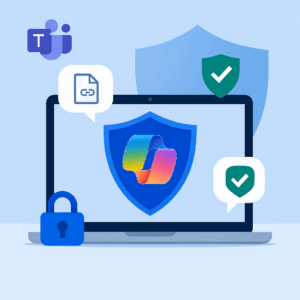Checking Out Copilot for Security
If Microsoft Teams is the hub of modern work, then it’s also the digital equivalent of Grand Central Station: busy, noisy, and filled with way too many places to get lost. It’s where projects happen, files are shared, and (let’s be real) where phishing attempts and careless clicks can wreak havoc faster than you can say “oops.”
 Microsoft knows this, and instead of leaving it up to IT to play digital hall monitor, they’re arming Teams with AI-powered security upgrades that make Copilot less of a “helpful assistant” and more of a silent bodyguard. Within the MVP community, we’ve been asking for this since the first Copilot announcements. Starting this fall, Teams will quietly begin protecting you in ways you may not even notice, but will definitely appreciate the moment someone tries to share a sketchy file.
Microsoft knows this, and instead of leaving it up to IT to play digital hall monitor, they’re arming Teams with AI-powered security upgrades that make Copilot less of a “helpful assistant” and more of a silent bodyguard. Within the MVP community, we’ve been asking for this since the first Copilot announcements. Starting this fall, Teams will quietly begin protecting you in ways you may not even notice, but will definitely appreciate the moment someone tries to share a sketchy file.
Official announcement here: Microsoft Security blog – New AI security features in Teams
What’s New in Teams Security
Microsoft is rolling out a series of protections designed to tackle the most common weak points in collaboration:
- Blocking dangerous file types: Executables, scripts, and other risky attachments get intercepted before you can accidentally open them.
- Malicious URL detection: Links in chat messages are scanned in real time. If it smells fishy, Teams warns you before you click.
- Screenshot protection: Sensitive calls (think board meetings or classified projects) can be locked down so screenshots can’t be captured.
- Screen sharing alerts: If you’re about to accidentally broadcast sensitive content — like payroll data or confidential slides — Teams will flag it.
- Defender for Office 365 integration: Adds domain-level blocking so IT doesn’t have to manually chase every suspicious file or link.
All of this is powered by AI running behind the scenes, using context to stop threats before they turn into incidents. More details from Microsoft: Defender for Office 365 overview.
Why AI-Driven Protection Matters
Traditional security has always been reactive: someone reports a phishing email, IT investigates, and by then damage is already done. AI flips that script.
With Copilot, Teams doesn’t just wait for users to notice. It analyzes patterns, behaviors, and content in real time. The moment a suspicious link or dodgy attachment enters the chat, it gets flagged. Think of it like an airbag: you hope you’ll never need it, but you’ll be grateful when it deploys.
And here’s the best part: employees don’t have to do anything differently. No extra clicks, no security training modules that feel like watching paint dry. The protections are woven directly into the tools they’re already using. Here are some real-world scenarios:
- The “Click Happy” Colleague: We all know the teammate who clicks every link like it’s their job. Now, if they try to open a malicious URL, Teams steps in with a warning, and sparing IT a frantic Monday morning cleanup.
- Board Meeting Gone Wrong: A confidential call where sensitive financial results are being shared. Screenshot protection ensures nothing escapes beyond attendees, no matter how trigger-happy someone’s keyboard shortcuts are.
- Oops, Wrong Window: You’re about to screen share and accidentally display a confidential HR file. Teams warns you before it turns into an awkward HR moment.
These are the kinds of mistakes that happen in real organizations every single day. Copilot’s value here isn’t just in stopping attackers — it’s in saving people from themselves.
Productivity + Security = The Real Win
What makes this particularly smart is the balance it strikes. Security teams don’t want to lock down collaboration to the point where no one can get anything done. And employees don’t want to feel like they’re being policed every time they share a file.
Copilot’s new security role is about guardrails, not roadblocks. It reduces IT overhead (no more manual investigations into every suspicious file), while empowering employees to work freely, knowing AI has their back.
This is the kind of integration that shows how Microsoft is evolving Copilot from being a productivity booster into something broader: the digital infrastructure of trust.
My Take
Honestly, I love this. As someone who focuses a lot on governance best practices (where HOW you execute is sometimes as important as WHAT you execute), I recognize that too often, security features are built like seat belts in the 1950s: technically available, but a pain to use. People skip them because they slow things down. By embedding protections into Teams itself, Microsoft makes security invisible and automatic.
For managers, this means less time worrying about what could go wrong. For IT, it means fewer headaches chasing down user mistakes. And for end users? It means you can finally click with confidence (well, most of the time).
Microsoft is quietly transforming Copilot into something more than a productivity assistant. It’s becoming your digital seatbelt: invisible until the moment it saves you. And in today’s world of relentless phishing attempts and “oops” moments, that feels less like a nice-to-have and more like an essential co-pilot for collaboration.




